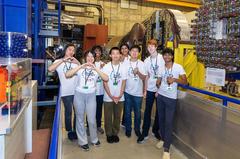Team SPEEDers on their first day in Hamburg. (Photo: DESY / Marta Mayer)
DESY has now eight SPEEDers on its campus – not anyone who drives over the speed limit, but rather teenagers from the US on a mission. That mission is to carry out their self-proposed experiment that had won the 2024 Beamline for Schools competition at the DESY II Test Beam, surpassing 461 teams from around the world. Their research could help define a novel way of measuring a beam of particles without interfering with it – important for the seamless operation of accelerators. As they do their work in this eleventh edition of the global physics competition, two further teams from Estonia and Japan are working at the European particle physics laboratory CERN in Geneva, which organises the competition.
The SPEEDers comprise eight pupils at the 11th and 12th grade from Andover High School in Andover, Massachusetts. Their proposal seeks to isolate readings of Smith–Purcell radiation, an obscure effect first detected by Edward Purcell and Steve Smith in the 1950s. This radiation occurs when an accelerated particle travels extremely close and parallel to a periodic metal surface, inducing a current in the metal and causing the radiation to be emitted from it. The students want to see if Smith–Purcell radiation can be isolated well enough to interpret something about the particle beam that generated it in the first place. When yes, it would lend more evidence toward a new technological method of monitoring energetic particle beams without disturbing them.
“We found that beam diagnostics was an interesting area, and that Smith–Purcell radiation was an interesting avenue had not yet been explored as a potential method,” says Richard Chen, member of the SPEEDers team. The team was inspired to investigate this form of radiation by looking at previous BL4S winning teams that did similar diagnostics work.
The team has two weeks to perform their experiment with the help of DESY support staff. “The facilities here are really amazing,” says Samyak Jain, one of the SPEEDers. “The people here are so helpful. We’ve learned from them already so much in a way that no physics textbook or googling could do for us.”
“Part of our mission as well is to learn about the scientific community outside of our home country,” says Jaiden Li, a member of the SPEEDers. “It’s very rewarding in that regard.”
In the meantime, two further teams, the Team Mavericks from Estonia and Sakura Particles from Japan, are both exploring muon detection in their experiments at CERN. The three teams have met and exchanged virtually since being announced as the winners. On 16 September, the teams met once again alongside dignitaries from their respective countries to mark the 10th anniversary of the BL4S programme. “The fact that CERN and DESY open their campuses to high school students is an incredible opportunity,” said US Deputy Consul General in Hamburg Abigail Greenwald at the event. “This contest empowers youth from around the world and amplifies the voices we need to hear most.”
On the topic of young people engaging with particle physics, the originator of the competition, CERN physicist Christoph Rembser, provided a look back at the past decade and all of the young people who had designed experiments and the ones who actually got to carry them out. His observation: “To see the dreams in the eyes of the young people is a great inspiration.”
BL4S was launched in 2014 to mark the 60th anniversary of CERN. After the success of the first edition, the competition continued and reached its 10th edition in 2023. Since 2014, 25 teams have been recognised as winners of BL4S, and more than 20,000 students from all over the world have participated in the competition. The number of participants has steadily increased in recent years, and this year 461 teams from 78 countries submitted an experiment proposal.
The BL4S collaboration between CERN and DESY began in 2019 during the shutdown phase of the CERN accelerators. This year, the German laboratory will host a winning team for the sixth time.
The 2024 Beamline for Schools Competition is sponsored via the CERN and Society Foundation, with support from the Wilhelm and Else Heraeus Foundation, Rolex, and anonymous sponsors.
Further Information:
https://beamlineforschools.cern/
https://beamlineforschools.cern/editions/2024-edition








